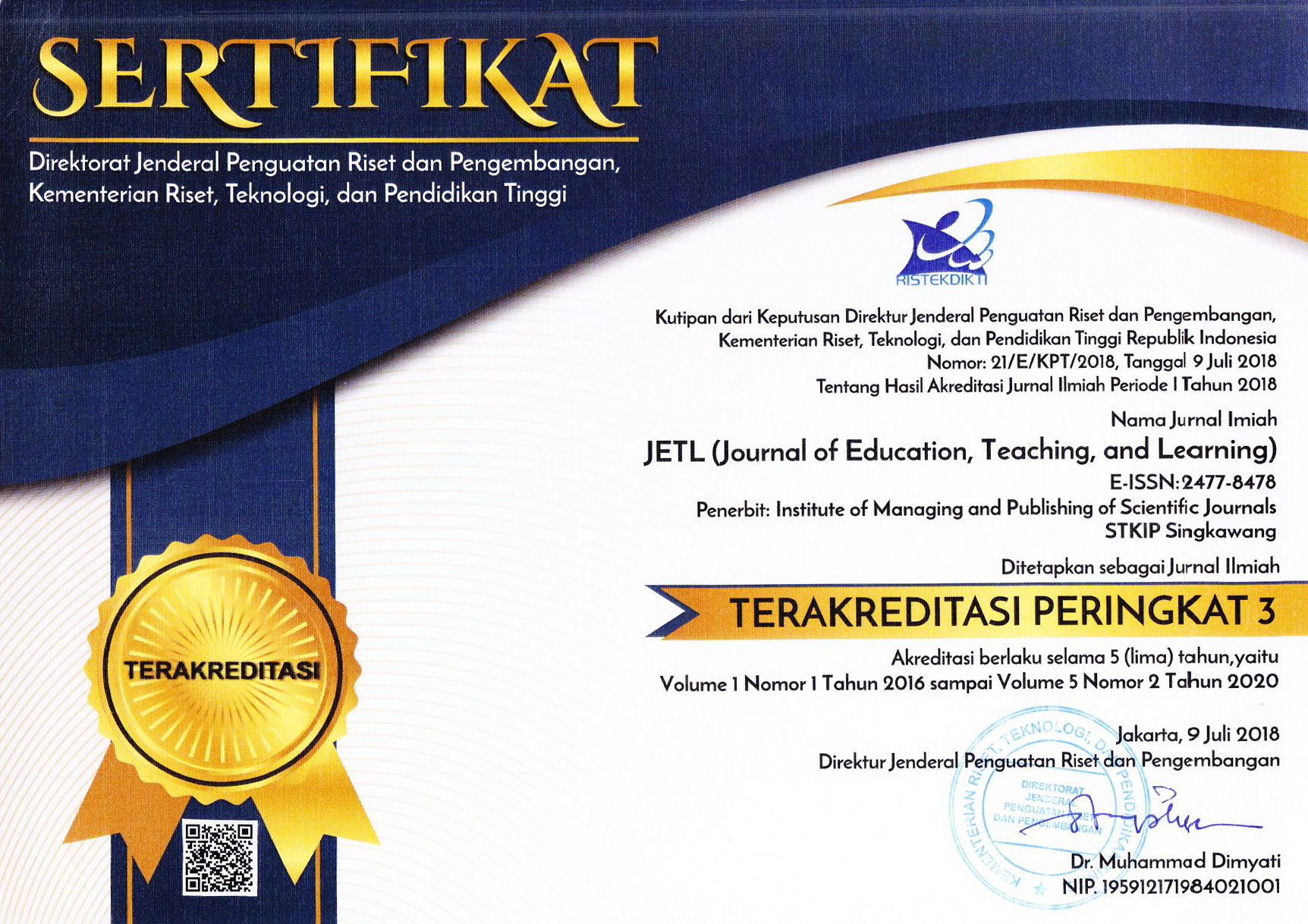Leading Teacher Collaboration in Elementary School Through School Leader Adaptive Skills: A PLS-SEM Approach
Abstract
Keywords
Full Text:
PDFReferences
Bradberry, T., & Greaves, J. (2012). Leadership 2.0: TalentSmart.
Chen, J., & Guo, W. (2020). Emotional intelligence can make a difference: The impact of principals’ emotional intelligence on teaching strategy mediated by instructional leadership. Educational Management Administration & Leadership, 48(1), 82-105.
Creswell, J. W., & Creswell, J. D. (2017). Research design: Qualitative, quantitative, and mixed methods approaches: Sage publications.
Dickerson, M. S. (2011). Building a collaborative school culture using appreciative inquiry. Researchers World, 2(2), 25.
Edmonson, S., Fisher, A., Brown, G., Irby, B., Lunenburg, F., Creighton, T., . . . Christianson, J. (2001). Creating a Collaborative Culture.
Hair, J. F., Risher, J. J., Sarstedt, M., & Ringle, C. M. (2019). When to use and how to report the results of PLS-SEM. European business review, 31(1), 2-24.
Hair Jr, J. F., Matthews, L. M., Matthews, R. L., & Sarstedt, M. (2017). PLS-SEM or CB-SEM: updated guidelines on which method to use. International Journal of Multivariate Data Analysis, 1(2), 107-123.
Hargreaves, A. (2019). Teacher collaboration: 30 years of research on its nature, forms, limitations and effects. Teachers and Teaching, 25(5), 603-621.
Heifetz, R. A., Heifetz, R., Grashow, A., & Linsky, M. (2009). The practice of adaptive leadership: Tools and tactics for changing your organization and the world: Harvard Business Press.
Hulland, J. (1999). Use of partial least squares (PLS) in strategic management research: A review of four recent studies. Strategic management journal, 20(2), 195-204.
Kerwin, S., Jordan, J. S., & Turner, B. A. (2015). Organizational justice and conflict: Do perceptions of fairness influence disagreement? Sport Management Review, 18(3), 384-395.
Laudert, E. (2018). Generation Z: Utilizing adaptive and authentic leadership to promote intergenerational collaboration at work.
Morin, A. (2011). Self‐awareness part 1: Definition, measures, effects, functions, and antecedents. Social and personality psychology compass, 5(10), 807-823.
Nelson, T., & Squires, V. (2017). Addressing complex challenges through adaptive leadership: A promising approach to collaborative problem solving. Journal of Leadership Education, 16(4).
Nias, J. (2005). Why teachers need their colleagues: A developmental perspective The practice and theory of school improvement: International handbook of educational change (pp. 223-237): Springer.
Northouse, P. G. (2021). Leadership: Theory and practice: Sage publications.
Nugroho, M. A. (2018). The effects of collaborative cultures and knowledge sharing on organizational learning. Journal of Organizational Change Management, 31(5), 1138-1152.
Olayvar, S. (2021). School Heads’ New Normal Leadership and Its Influence on Collaborative School Culture.
Park, J.-H., & Ham, S.-H. (2016). Whose perception of principal instructional leadership? Principal-teacher perceptual (dis) agreement and its influence on teacher collaboration. Asia Pacific Journal of Education, 36(3), 450-469.
Parlar, H., Turkoglu, M. E., & Cansoy, R. (2021). Instructional leadership as a predictor of collaborative culture in schools. International Journal of Leadership in Education, 1-24.
Rachmadtullah, R., Yustitia, V., Setiawan, B., Fanny, A. M., Pramulia, P., Susiloningsih, W., . . . Ardhian, T. (2020). The challenge of elementary school teachers to encounter superior generation in the 4.0 industrial revolution: Study literature. International Journal of Scientific & Technology Research, 9(4), 1879-1882.
Richter, M. M., Lewis, T. J., & Hagar, J. (2012). The relationship between principal leadership skills and school-wide positive behavior support: An exploratory study. Journal of Positive Behavior Interventions, 14(2), 69-77.
Sarid, A. (2021). Crossing boundaries: Connecting adaptive leadership and social justice leadership for educational contexts. International Journal of Leadership in Education, 1-22.
Simons, T., Leroy, H., Collewaert, V., & Masschelein, S. (2015). How leader alignment of words and deeds affects followers: A meta-analysis of behavioral integrity research. Journal of Business Ethics, 132, 831-844.
Squires, V. L. (2015). Tackling complex educational challenges through adaptive leadership. Antistasis.
Torres, D. G. (2019). Distributed leadership, professional collaboration, and teachers’ job satisfaction in US schools. Teaching and Teacher Education, 79, 111-123.
Vangrieken, K., Dochy, F., Raes, E., & Kyndt, E. (2015). Teacher collaboration: A systematic review. Educational research review, 15, 17-40.
Vangrieken, K., & Kyndt, E. (2020). The teacher as an island? A mixed method study on the relationship between autonomy and collaboration. European Journal of Psychology of Education, 35(1), 177-204.
Voorhees, C. M., Brady, M. K., Calantone, R., & Ramirez, E. (2016). Discriminant validity testing in marketing: an analysis, causes for concern, and proposed remedies. Journal of the academy of marketing science, 44, 119-134.
Waldron, N. L., & McLeskey, J. (2010). Establishing a collaborative school culture through comprehensive school reform. Journal of educational and psychological consultation, 20(1), 58-74.
Williams Jr, R. I., Raffo, D. M., Randy Clark, W., & Clark, L. A. (2022). A systematic review of leader credibility: its murky framework needs clarity. Management Review Quarterly, 1-44.
DOI: http://dx.doi.org/10.26737/jetl.v9i1.4799
Refbacks
- There are currently no refbacks.

This work is licensed under a Creative Commons Attribution-NonCommercial 4.0 International License.
Published by:
Institute of Managing and Publishing of Scientific Journals STKIP Singkawang
Sekolah Tinggi Keguruan dan Ilmu Pendidikan (STKIP) Singkawang
Address : STKIP Singkawang, Jalan STKIP - Kelurahan Naram Singkawang, Kalimantan Barat, INDONESIA, 79251
No. Telp. : +62562 420 0344
No. Fax. : +62562 420 0584
JETL (Journal of Education, Teaching, and Learning)
e-ISSN : 2477-8478
p-ISSN : 2477-5924

Editor in Chief Contact: [email protected] / Wa: +6282142072788
Publisher Contact: [email protected] / Wa: +6282142072788
Management Tools
JETL Indexed by:
JETL (Journal of Education, Teaching, and Learning) is licensed under a Creative Commons Attribution-NonCommercial 4.0 International License.











